
The Fort Wayne Old City Hall Building in downtown Fort Wayne, Indiana operates as a museum known as The History Center, and has served as headquarters for the Allen County–Fort Wayne Historical Society since 1980. The Richardsonian Romanesque style sandstone building was designed by the architectural firm Wing & Mahurin and built in 1893. It served as a functioning city hall for the city until 1971 when local officials moved to the City-County Building.

The Jean Baptiste Point Du Sable Homesite is the location where, around the 1780s, Jean Baptiste Point du Sable located his home and trading post. This home is generally considered to be the first permanent, non-native, residence in Chicago, Illinois. The site of Point du Sable's home is now partially occupied by and commemorated in Pioneer Court at 401 N. Michigan Avenue in the Near North Side community area of Chicago, Illinois.

Oakland Plantation, originally known as the Jean Pierre Emmanuel Prud'homme Plantation, and also known as Bermuda, is a historic plantation in and unincorporated area of Natchitoches Parish, Louisiana. Founded as a forced-labor farm worked by enslaved Black people for White owners, it is one of the nation's best and most intact examples of a French Creole cotton plantation complex. The Oakland Plantation is now owned by the National Park Service as part of the Cane River Creole National Historical Park.

Magnolia Plantation is a former cotton plantation in Natchitoches Parish, Louisiana. The site was declared a National Historic Landmark in 2001, significant as one of the most intact 19th-century plantation complexes in the nation, as it is complete with a suite of slave cabins and numerous outbuildings and period technology. Included in the Cane River Creole National Historical Park, Magnolia Plantation is also a destination on the Louisiana African American Heritage Trail. It is one of two plantations in the park; the other is Oakland Plantation.

Melrose Plantation, also known as Yucca Plantation, is a National Historic Landmark located in the unincorporated community of Melrose in Natchitoches Parish in north central Louisiana. This is one of the largest plantations in the United States built by and for free blacks. The land was granted to Louis Metoyer, who had the "Big House" built beginning about 1832. He was a son of Marie Thérèse Coincoin, a former slave who became a wealthy businesswoman in the area, and Claude Thomas Pierre Métoyer. The house was completed in 1833 after Louis' death by his son Jean Baptiste Louis Metoyer. The Metoyers were free people of color for four generations before the American Civil War.

St. Augustine Catholic Church and Cemetery, or the Isle Brevelle Church, is a historic Catholic parish property founded in 1829 near Melrose, Natchitoches Parish, Louisiana. It is the cultural center of the Cane River area's historic French, Spanish, Native American and Black Creole community.
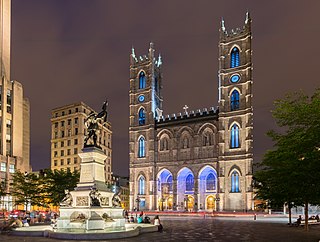
The Notre-Dame Basilica is a basilica in the historic district of Old Montreal, in Montreal, Quebec, Canada. The church is located at 110 Notre-Dame Street West, at the corner of Saint Sulpice Street. It is located next to the Saint-Sulpice Seminary and faces the Place d'Armes square.

The Guibourd House, also known as La Maison de Guibourd, is an example of poteaux-sur-solle sealed with bouzillage construction. The structure was built around 1806 and was the home of Jacques Jean Rene Guibourd and his family.

Fort St. Jean Baptiste State Historic Site, or Fort des Natchitoches, in Natchitoches, Louisiana, US, is a replica of an early French fort based upon the original blueprints of 1716 by Sieur Du Tisné and company. The settlement which became the town of Natchitoches was founded in 1714 by French Canadian Louis Antoine Juchereau de St. Denis as the first permanent European settlement in the lands later encompassed by the Louisiana Purchase. In 1722, Juchereau de St. Denis in 1722 became commandant of Fort St. Jean Baptiste des Natchitoches. The fort was devised as a trading and military outpost to counter any Spanish incursions into French territory. Soon it became a center of economic significance, particularly with neighboring Caddo tribes. After 1764, Fort St. Jean was abandoned, with the transfer of Louisiana to Spain. The exact location of the fort has since been lost. In 1979, the fort was reconstructed in the vicinity of where the fort is believed to have been located. Today, the fort is an attraction within the Cane River National Heritage Area. The site is also host to living history re-enactments of what life in the fort was like in the 1750s.

The Sibley Historic Site is the site of Henry Hastings Sibley's home, who was the regional manager of the American Fur Company and Minnesota's first governor. It is one of the 26 historical sites that are operated by the Minnesota Historical Society. Located in what is now the city of Mendota, the site consists of four limestone buildings and a large lawn area. Three of the buildings are open for touring, including a fur company cold store from 1843 and the 1840 home of fur trader and hotelier Jean-Baptiste Faribault.
The Historic Roman Catholic Properties in Mobile Multiple Property Submission is a multiple property submission of Roman Catholic properties in Mobile, Alabama, that were listed together on the National Register of Historic Places. The submission covers cemetery, church, convent and other religious properties that are historically or architecturally significant.

St. Elizabeth of Hungary Catholic Church is a historic Roman Catholic church is located at 114 Louisiana Highway 403 in Paincourtville, Louisiana, in Assumption Parish. In 2000 the ecclesiastical parish of St. Elizabeth was clustered with St. Jules in Bell Rose, also in the Diocese of Baton Rouge.

The Basilica of the Immaculate Conception is a minor basilica located in Natchitoches, Louisiana, United States. It is also a parish church in the Diocese of Alexandria. The church building is the seventh structure to house the parish and was at one time the cathedral for the Roman Catholic Diocese of Natchitoches. As the Church of the Immaculate Conception it was listed as contributing property in the Natchitoches Historic District on the National Register of Historic Places.
The Dulcito Plantation is a historic house built c. 1850, and formally was a Southern plantation, located at 5918 West Old Spanish Trail in New Iberia, Louisiana. This is one of the few remaining buildings of the area that highlights the pre-Civil War architectural heritage, despite having some alterations. The house was listed on the National Register of Historic Places on July 22, 1994.
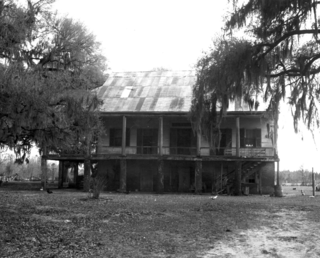
The Darby Plantation is a Southern plantation located about 2.1 miles (3.4 km) northwest of New Iberia, Louisiana.
Jean Baptiste Thibodaux House, also known as Rosella Plantation House, is a historic mansion located at 3515 LA 308, about 1.8 miles (2.9 km) northwest of Raceland, Louisiana.
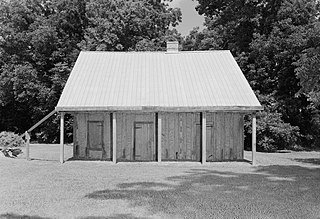
The Badin-Roque House is a historic house located along Louisiana Highway 484, about 6.6 miles (10.6 km) southeast of Natchez in the community of Isle Brevelle.
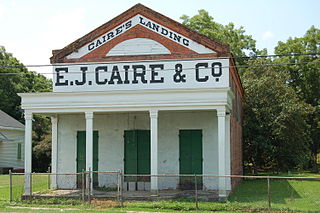
The E.J. Caire & Co. Store, at 2403-2407 Louisiana Highway 18 in Edgard, in St. John the Baptist Parish, Louisiana, was built in 1855. It was listed on the National Register of Historic Places in 2001.

Isle Brevelle is an ethnically and culturally diverse community, which began as a Native American and Louisiana Creole settlement and is located in Natchitoches Parish, Louisiana. For many years this area was known as Côte Joyeuse. It is considered the birthplace of Creole culture and remains the epicenter of Creole art and literature blending European, African, and Native American cultures. It is home to the Cane River Creole National Historical Park and part of the Louisiana African American Heritage Trail.
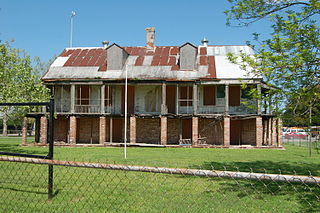
Godchaux–Reserve Plantation, also known as Godchaux–Boudousquie Plantation, and the Reserve Plantation, is a former plantation, former site of a sugar refinery, and once included a historic house built in 1764, located in Reserve, St. John the Baptist Parish, Louisiana.



















